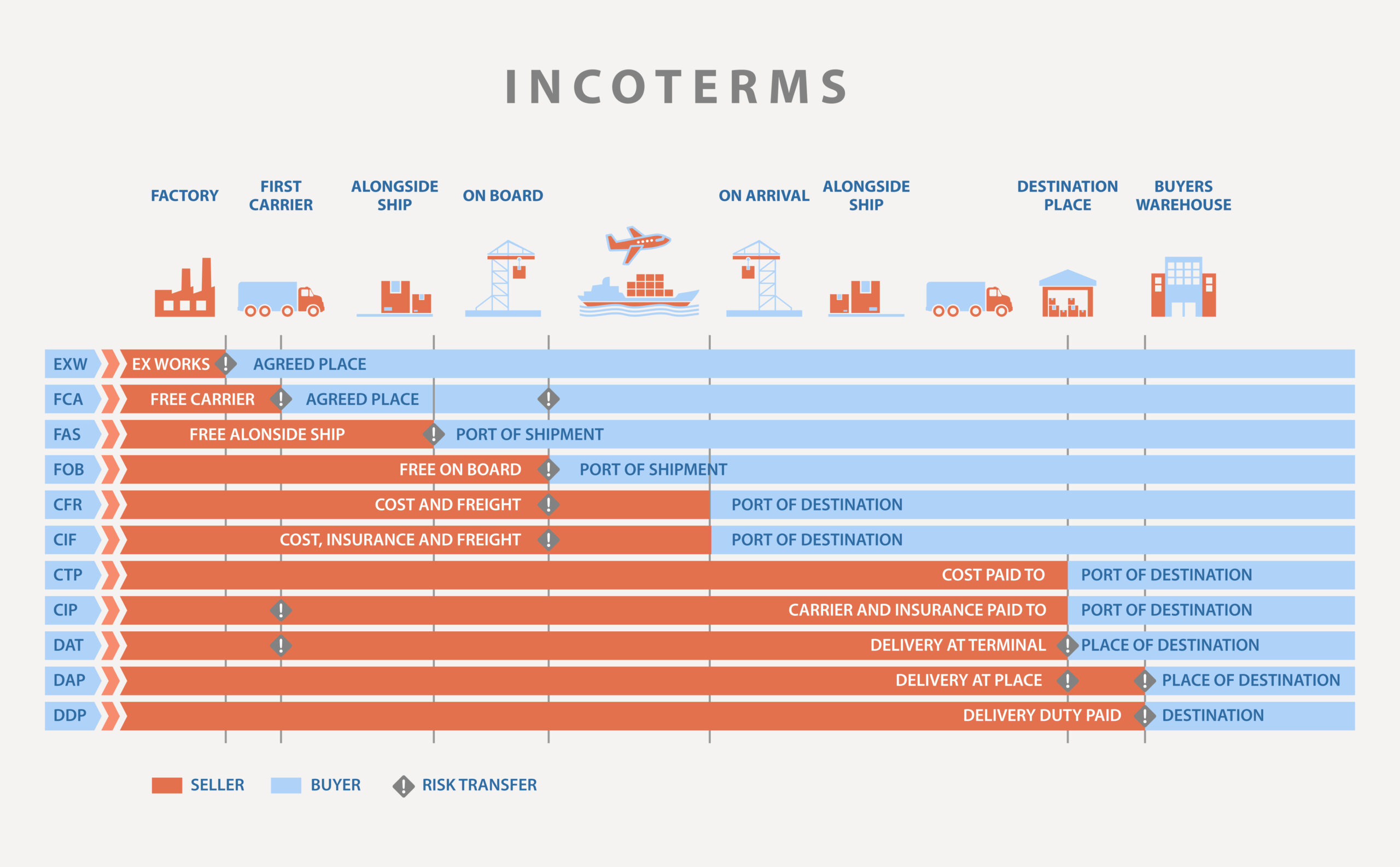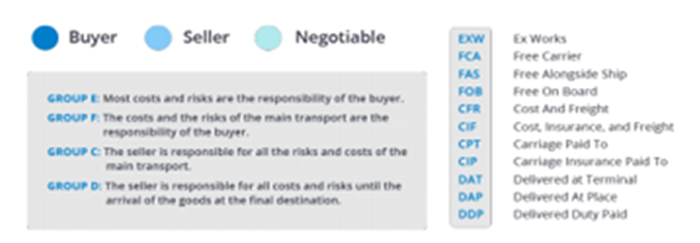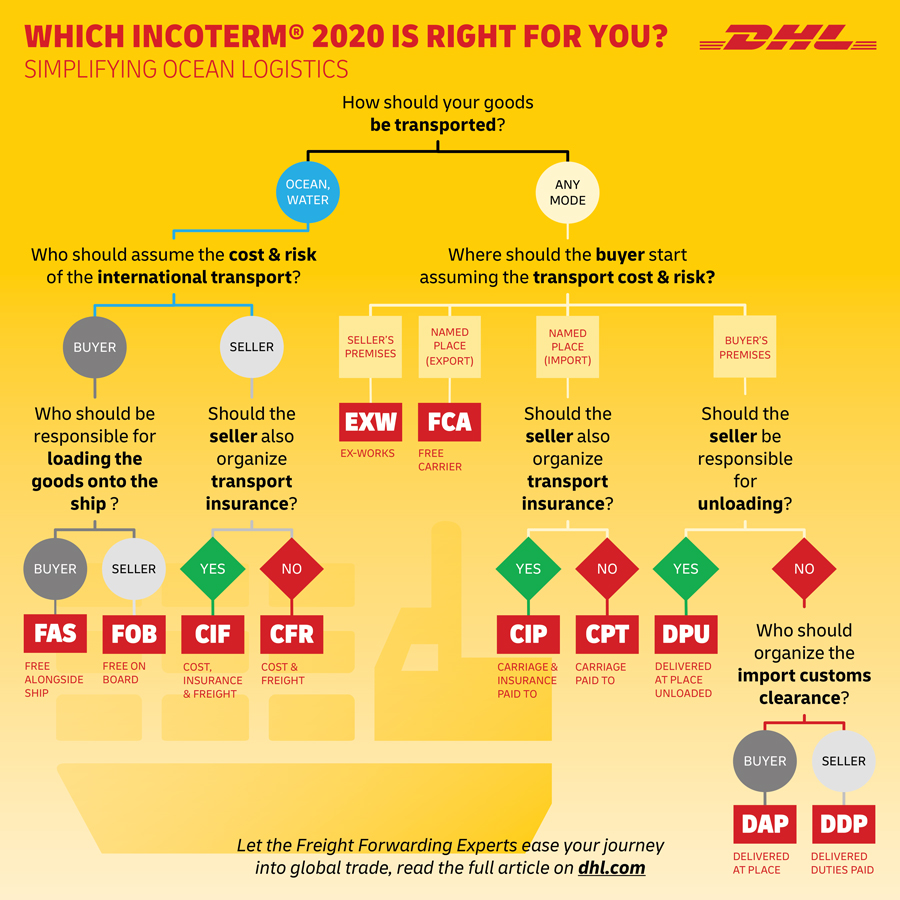Know Your Incoterms
Incoterms are critical when importing and exporting goods. In order to best move your goods effectively around the world, it is key to understand Incoterms and the impact that they have in terms of responsibilities (and cost!). In this section of the Knowledge Centre we will give you the full low down on Incoterms, including the following:
- What are they?
- Why are they important?
- Learn how to use them to your advantage
Let’s start at the beginning…What are Incoterms?
Incoterms are made up of a set of 11 internationally recognised rules (created by the International Chamber of Commerce), which define the responsibilities of sellers and buyers when it comes to shipping. They cover, as a minimum, who is responsible for the following:
Main functions of the Incoterms:
- Cost split: Who bears the costs for each element – Buyer or Shipper?
- Division of responsibilities: which side takes on which obligations on which route?
- Risk transfer: At which point does each side take on the risk for the shipment?
It is critical that you include the correct Incoterm in your agreement and that they are detailed on your invoice. Otherwise, you face added risk and potentially more costs than you had budgeted!
Other functions of the Incoterms
Incoterms answer the following questions:
- Which party is responsible for the shipping costs?
- Which party is responsible for the insurance costs?
- Which party is responsible for the import costs?
- Which party is responsible for customs clearance?
- Which party is responsible for transport and where does this go?
- Which party is liable for the goods and until when?
The 11 Incoterms
The 11 individual rules are determined by the International Chamber Commerce (ICC). Famliarising yourself with Incoterms will help smooth the movement of goods by clearly defining who is responsible for which steps of the transaction in the flow of goods from one country to another.
The Incoterms were updated in 2020 and have been grouped into two categories that reflect the different modes of transport. Of these 11, seven apply to any mode(s) of transport and four apply to sea, land or inland waterway.
Seven Incoterms for any mode(s) of transport are:
EXW - Ex Works (insert place of delivery)
The seller passes the goods to the seller (or seller representative e.g. Freight Forwarder) at an agreed location, often the factory. From that moment, the buyer bears almost all costs and risks during the entire shipping process. The buyer is responsible for local transport (e.g. in China) and customs clearance for export.
FCA - Free Carrier (Insert named place of delivery)
The seller makes the goods available at their own risk and expense at their premises or at an agreed place. In both cases, the seller is responsible for the clearance of the goods through customs for export. It can also be agreed that the buyer must instruct the carrier to transfer a “Bill of Lading (BL)” with a note on board to the seller.
CPT - Carriage Paid to (insert place of destination)
The seller has the same responsibilities as with FCA, but in the case of CPT, the seller also pays the costs of delivery.
CIP - Carriage and Insurance Paid To (insert place of destination)
CIP (Carriage And Insurance Paid To) means that the seller is responsible for delivery, delivery costs, and insurance costs of the goods, until they are transferred to the first carrier tasked with transporting the goods. Once this delivery takes place, the buyer takes on all responsibility.
DAP - Delivered at Place (insert named place of destination)
The seller bears the costs and risks during the transport of the goods to an agreed address. As soon as the goods have arrived at this address and are ready for unloading, the risk passes to the buyer.
DPU - Delivered at Place Unloaded (insert of place of destination)
The seller is responsible for the costs and risks of delivering goods to an agreed destination where goods can be unloaded for further transport. The seller arranges the customs export clearance and will deliver and unload the goods to an agreed location. The buyer arranges the import customs clearance and any associated rights.
DDP - Delivered Duty Paid (Insert place of destination).
The seller bears the costs and risks of transport, carries out the export and import responsibilities and pays any import duties. The seller arranges the transport of the goods to the final location. As soon as the goods have arrived at the address and are ready for unloading, the risk passes to the buyer.
The four Incoterms 2020 for Sea and Inland Waterway transport are:
FAS - Free Alongside Ship (insert name of port of loading)
The seller bears all costs and risks until the goods are delivered next to the ship. At the point of loading on the ship, the risk moves to the buyer and the buyer is also responsible for the export clearance and import clearance.
FOB - Free on Board (insert named port of loading)
The seller bears all costs and risks until the goods are on board the ship. The seller also arranges the export clearance. As soon as the goods have been delivered to the ship, the buyer bears all onward responsibilities.
CFR - Cost and Freight (insert named port of destination)
Similar to FOB, but with CFR, the seller must also pay for the transport of the goods to the destination port.
CIF - Cost Insurance and Freight (insert named port of destination)
The seller has the same obligations as with CFR but also pays the (minimum) insurance costs. The buyer must pay for more comprehensive insurance, if required.
Summary - There are 4 distinct groups that detail who has hat responsibility:
Group 1: EXW – the only ‘collection’ Incoterm. The buyer takes responsibility for all costs and risks during the shipping process
Group 2: FCA/FAS/FOB – The seller does cover any of the risks or costs of the main element of the transport. Once the goods are handed to the carrier, the responsibility is transferred to the buyer
Group 3: CPT/CIP/CFR/CIF – The seller bears the costs of the main transport. Once the goods are handed to the carrier, only the risk of the transportation is moved to the buyer. The costs of the transportation and the insurance remain with the seller.
Group 4: DAP/DPU/DPP – The seller bears all costs and all the risks until the arrival of the goods arrive at the end destination


Which Incoterm should I use?
When deciding which Incoterm to use, it is important to consider where you want to take responsibility from the seller and where you wish to take the risk. If you want assistance in deciding which Incoterm to select, we have included a flowchart (designed by DHL) diagram to help inform your decision:

Need more help?
Of course, this being Logisto, if you need more help then we are here for you. We have created a detailed list of freight forwarders that can assist with this (and much more!). Please browse the Directory in order to find a company to support you and if there are any issues, please reach out to the LOGISTO Team.
Thank you
The LOGISTO Team